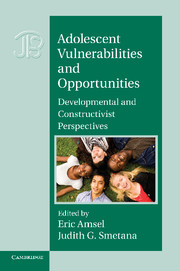1 - Constructivist Processes in Adolescent Development
Published online by Cambridge University Press: 07 October 2011
Summary
In John Godfrey Saxe’s poem, The Blind Men and the Elephant, based on earlier Chinese and Indian fables, six blind men surround and feel some part of an elephant. Each of them thinks that his part reveals the true nature of the beast. Saxe makes clear that the lesson to be learned involves the dangers in generalizing knowledge claims that are limited in scope. This lesson translates well into research on adolescent development. Although adolescents are popularly seen as having an unpredictable and inexplicable nature, any good adolescence textbook documents a range of conflicting alternative images afforded by multiple theoretical perspectives in the field. Adolescents are presented as apprentices (who participate in forms of cultural activities), architects (who construct normative mental structures and processes), and juveniles (who accommodate to a long, slow biological maturation processes).
Just as Saxe warns, each of the theoretical frameworks underlying these images highlights a particular set of factors or forces as central to understanding adolescence, which is in turn used to paint these generalized but conflicting pictures. For example, fifty or so years ago, adolescence was seen as time for acquiring morality, rationality, and an autonomous sense of self and identity (Erikson, 1968; Inhelder & Piaget, 1958; Kohlberg, 1969), a position articulately defended by Moshman (2005). The constructivist theoretical framework that underlies much of this work presents a view of adolescents as designing their own development by actively seeking to make sense of themselves and their physical and social worlds. These powerful ideas, and the image of adolescents as architects that they imply, gave rise to a research program defining the normative developmental trajectory in adolescence as a progression toward rationality, morality, and autonomy. Constructivists were not blind to the challenges that arise as adolescents confront the trials and tribulations of accommodating to puberty and adopting adult social roles. But the theoretical and empirical goal was to lay out the pathways leading toward developmental endpoints rather than charting the deviations, diversions, and detours in development.
Information
- Type
- Chapter
- Information
- Adolescent Vulnerabilities and OpportunitiesDevelopmental and Constructivist Perspectives, pp. 1 - 20Publisher: Cambridge University PressPrint publication year: 2011
References
Accessibility standard: Unknown
- 1
- Cited by
